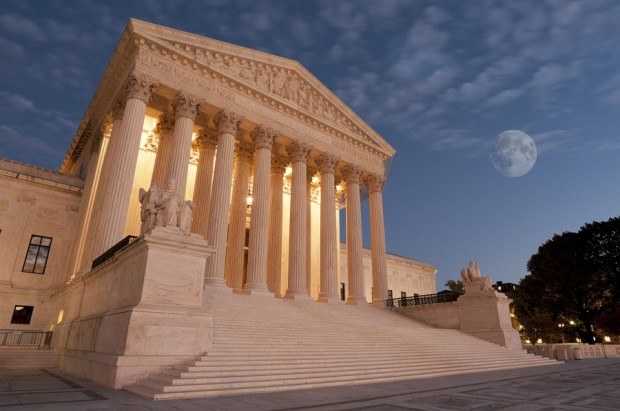Steel workers who do their jobs wearing flame-retardant gear tried to convince the U.S. Supreme Court on Monday that they should be paid for the time they spend “donning and doffing” such items before and after their shifts.
In a case that could affect unionized workers in poultry processing, meat packing and other sectors, roughly 800 current and former workers at the United States Steel Corp plant in Gary, Ind., are seeking the extra pay.
A crucial point in the case is the difference between “clothes” and “protective gear.”
In High Court arguments, the nine justices struggled to clearly differentiate between the two—a task that the U.S. Labor Department has only made harder over the years.
The distinction is important because unionized employees are not entitled to pay for the time it takes to change clothes before and after each shift if their union and their employer have agreed to this by custom or agreement.
Under the law, workers do have to be paid for the time it takes to put on and take off essential protective workplace gear that is not “clothes,” regardless of what their contract says.
The U.S. Steel workers say that flame-retardant jackets and pants, work gloves, wristlets, hard hats and other items they have to wear are “personal protective equipment,” not clothes.
U.S. Steel disagrees, saying any wearable item is clothes. As a result, the company says, it should not have to pay unionized employees for “donning and doffing.”
The court seemed to approach the case with the big picture in mind, said Jessica Schauer Lieberman, a lawyer at Seyfarth Shaw, who attended the hearing but was not involved in the case.
“The justices were clearly looking to make a broad rule. They weren’t looking to treat this as a narrow case where they just decide the specific items worn by the plaintiffs at the U.S. Steel plant,” she said afterward.
A decision from the court is expected by late June 2014, when the court’s current term ends.
Justices Weigh In
Conservative Justice Antonin Scalia told Lawrence DiNardo, the attorney representing U.S. Steel, that the company’s interpretation of the law is too broad.
“The word of the statute is ‘clothes,'” Scalia said during the arguments. “And nobody would consider eyeglasses or a wristwatch or some of this other specialized equipment to be clothes. I mean, the word is what it is.”
Justice Sonia Sotomayor, a liberal, told Eric Schnapper, the attorney representing the workers, that while the company’s definition “might go too far,” she had “a problem with things that look like clothes.”
Schauer Lieberman said the justices appeared to be skeptical of the plaintiffs’ argument “that any item that is intended to protect you from a workplace hazard is excluded from clothing, but I think that they were also having trouble with what the right rule would be in its place.”
Justice Elena Kagan questioned why the court was being asked to sort out the issue, instead of the Labor Department, which has in the past issued conflicting guidance. “It seems the quintessential question of statutory interpretation to which we would normally defer to the agency,” Kagan said.
Scalia countered: “Too complicated is why.”
Mixed Messages From Labor Dept
The U.S. Steel case came from Chicago’s 7th U.S. Circuit Court of Appeals, which took note of the Labor Department’s conflicting stances on workplace clothing. The 7th Circuit concluded that the items donned by the U.S. Steel workers were not clothes, but safety gear.
During the Clinton administration, the department’s position was that protective equipment such as hats, boots and gloves were not clothes. Then during the Bush administration, a 2002 Labor Department letter stated that such gear actually was clothing. This changed again in 2010, under President Barack Obama, when the 2002 letter was revoked, reverting the official position so the items were viewed again as protective gear.
“It would be a considerable paradox if, before 2001, the plaintiffs would win because the president was a Democrat; between 2001 and 2009 the defendant would win because the president was a Republican; and in 2012 the plaintiffs would win because the president is again a Democrat,” 7th Circuit Judge Richard Posner wrote.
The 7th Circuit panel concluded that, even though some of the items donned by U.S. Steel workers were not clothes, it took the workers so little time to pull them on and off that they were not entitled to compensation.
Grocery Costs
Narrowing the definition of “clothes” could be costly to the grocery industry, another sector that could be affected, Littler Mendelson attorney Tammy McCutchen said in a friend-of-the-court brief filed with the court on behalf of the Grocery Manufacturers Association.
If that industry’s 2.5 million workers were entitled to back pay of just 10 minutes a day each, the cost to employers would be $1.6 million for every thousand affected employees.
“It doesn’t sound like much, but it adds up really quick,” McCutchen told Reuters.
McCutchen, while at the Labor Department, signed the 2002 letter during the Bush administration that revised the agency’s definition of protective gear versus clothing.
Shares in U.S. Steel closed up 4.4 percent at $26.91 each in moderately bullish New York Stock Exchange trading.
The case is Sandifer v. United States Steel Corporation, U.S. Supreme Court, No. 12-417.





















 Surge of Supercharged Hurricanes Prompt Call for Cat 6 Classification
Surge of Supercharged Hurricanes Prompt Call for Cat 6 Classification  Why ‘Good Enough’ Is Killing Insurance: The Hidden Cost of Satisficing
Why ‘Good Enough’ Is Killing Insurance: The Hidden Cost of Satisficing  Why the Middle Market Matters and How Insurers Can Capture It
Why the Middle Market Matters and How Insurers Can Capture It  Berkshire Hathaway Enters Post-Buffett Era as Share Prices Fall
Berkshire Hathaway Enters Post-Buffett Era as Share Prices Fall 
